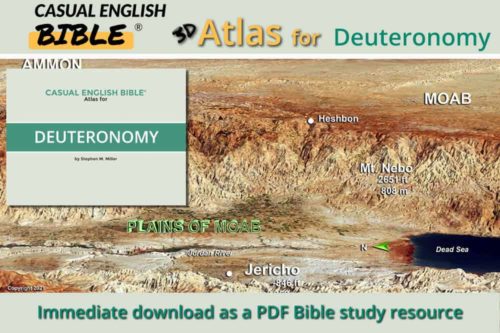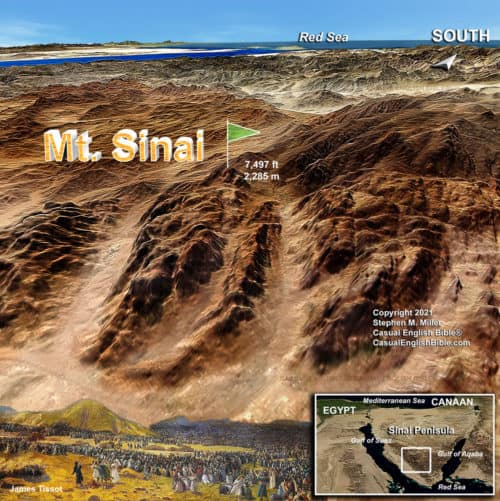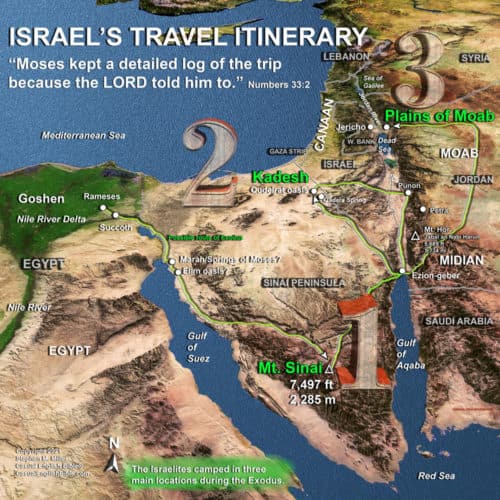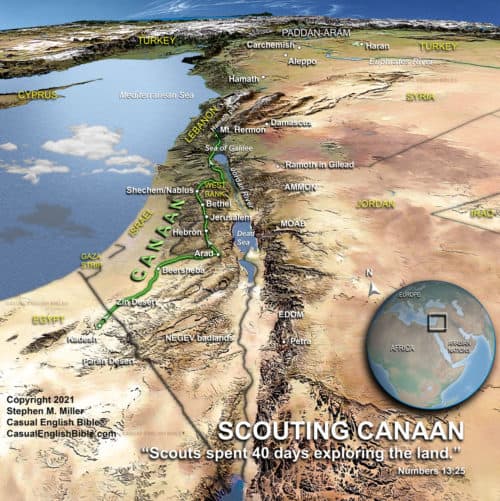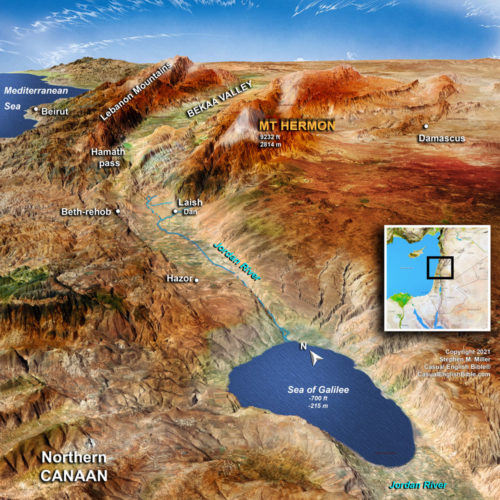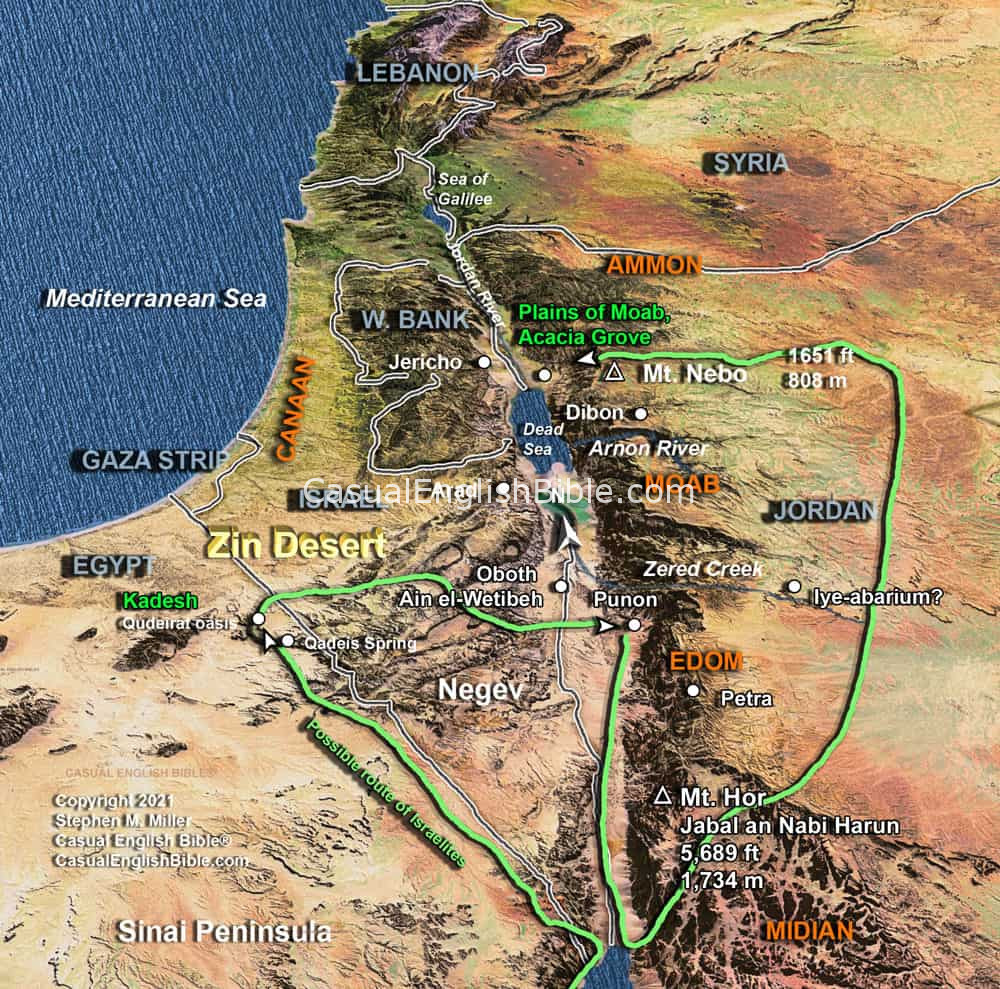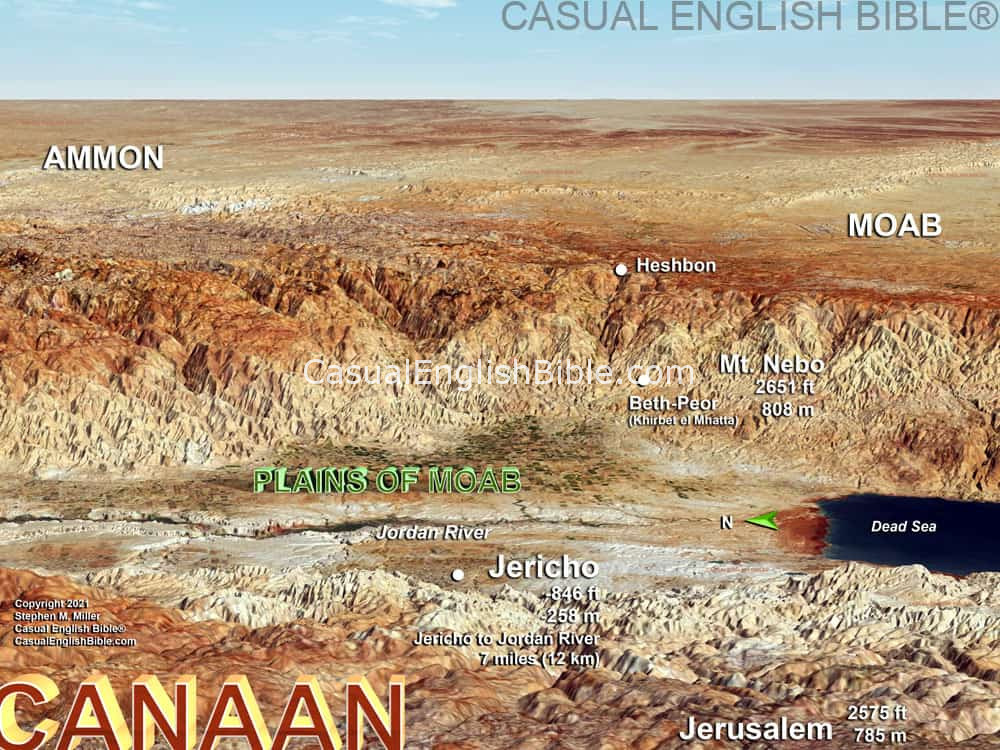Deuteronomy 1
Reminding Israelites where they came from
Forty years on an 11-day trip
1This is a report of what Moses told the people of Israel while they camped in a desert along the Jordan River Valley. [1] They pitched their tents east of the river, near the town of Suph. The town of Paran [2] was off to one side of the camp. Towns of Tophel, Laban, Hazeroth, and Dizahab were off to the other side.2Normally, the walk from Mount Sinai [3] to the oasis at Kadesh-barnea [4] takes 11 days, [5] on the trail along the Mount Seir [6] hills. 3Yet here the Israelites were, 40 years, 11 months, and one day after leaving Egypt. This is when Moses spoke to them, to remind them of everything the LORD told them to do. 4Moses did this after Israel defeated the Amorite king, Sihon, who ruled from the town of Heshbon, and King Og of Bashan, who ruled from his capital city of Ashtaroth. 5The Israelites were camped on Moab’s side of the Jordan River. That’s where Moses started going over the laws God gave Israel to obey.
The day they left Mt. Sinai
6Moses said: The LORD told us at Mount Sinai, “You’ve stayed here long enough. 7Time to get going. Head up to the Amorite hills. [7] Then travel all around the region. Go to the Arabah valley and hills, to the Negev, and then all the way to the Canaanite coastline. Go up to Lebanon and keep going all the way to the Euphrates River.8Look around. This is the land I gave you. Take it. It’s yours. This is the land I promised to give your ancestors Abraham, Isaac, and Jacob. I told them I would give it to their descendants.”
When Moses appointed officials to help him
9While we were there, I told you, “I can’t take care of you by myself anymore. I need some help. 10The LORD your God has given you a lot of children. Such a great blessing. There are more of you down here than stars in the sky. 11May the LORD, the God of your ancestors, keep it up. May he make the Israelite people a thousand times larger, as he promised. 12But you’re already too large of a crowd for me to manage. I can’t solve this many problems or settle these many arguments. Not by myself. 13So pick some men in your tribes to help me. Choose men who are wise and experienced leaders. I’ll appoint them as your tribal leaders.” 14You told me, ‘That’s a good plan.’”15I gave those wise and experienced men you chose the job of leading you. I delegated authority to other leaders, too. I put some in charge of 1,000 people. And I put others in charge of groups of 100, others of 50, and others of 10. 16I gave them these instructions: “Listen to the problems your people bring to you. Settle disputes fairly. Treat everyone that way. It doesn’t matter if a dispute involves two Israelites or if it’s between an Israelite and a foreigner living in your community. 17Treat everyone as equals. It doesn’t matter if someone is rich and famous or poor and overlooked. Don’t be intimidated by anyone. Don’t be afraid to treat people fairly. When you do that, your judgment call has God’s support. Also, I’ll be available to hear any hard case you decide to send to me.” 18Then I filled in the details for you, showing you how to make all these plans work.
Scouting Canaan
19When the LORD our God told us to leave Mount Sinai, we traveled through that horrible desert wasteland. We headed toward the hills where the Amorite people live, and finally arrived at the Kadesh-barnea oasis.20I told you, “We’re here now, in the Amorite hills that the LORD our God will give us. 21Look at this land. The LORD your God has put it right here in front of you. Go in and take it. God told your ancestors he would give it to you. Well, here it is. Don’t be afraid to take the land. Don’t get scared off.”
22That’s when you pushed back at me and said, “First, let’s send in some scouts. Have them explore the land and tell us what they saw. They can suggest the best route, and which cities we should take.” 23I agreed to that. I chose a dozen scouts, one from each tribe. 24They headed into the highlands and reached Cluster Valley, [8] which they explored. 25They brought us fruit from there, along with a report. They said, “The LORD our God is giving us a wonderful land.”
Israelite cowards at Canaan’s border
26But you decided not to go any further. You disobeyed the LORD your God, who told you to go in. 27Instead, you people sat around in your tents, complaining. You said, “The LORD must hate us. He brought us out of Egypt. But for what? To let the Amorites slaughter us? 28What can we do now? The scouting report is terrifying. The scouts said, ‘These people are huge, and much taller than us. They have massive cities protected behind towering walls. If that’s not bad enough, we saw the giants descended from Anak.’” [9]29I tried to calm you. I said, “Don’t be afraid of these people. There’s nothing to worry about. 30The LORD your God will lead the charge into battle. He’ll fight for you, just as he did before. Come on, people. You’ve seen him do it. 31You were there in the desert wasteland when he carried you through that terrible place like a parent carries a child. He hauled you all the way here.
32Yet you have the chutzpah [10] to tell him you don’t trust him. 33He’s the one who travels in front of you. He leads the way with a column of fire at night and a column of smoke [11] in the day.”
34The LORD heard what you said, and it made him angry enough to swear an oath against you: 35“I promised your ancestors that their descendants would live in a good land. Well, you aren’t those descendants. Not one of you wicked people will live to see this good land.” 36Caleb the son of Jephunneh is an exception. He’ll not only live to see it. I’ll give him and his family the land he walks on because he trusted the LORD.” 37The LORD was angry with me, too. He told me, “You can’t go there either.” 38Joshua the son of Nun is the other exception. He’s going to lead Israel into the land. So, support and encourage him.
39The LORD said, “As for your children—the ones you said would get captured by your enemies—they’ll see the land and live there. I’m giving it to them. 40As for you, turn around and go back to where you came from. Head back toward the desert wasteland, in the direction of the Reed Sea.” [12] 41That’s when you told me, “We were wrong. We’re guilty because of what we did to the LORD. So now, we’ll do what the LORD originally commanded. We’ll go and fight.” Then all the men got their weapons and walked into the hills where the enemies lived. 42But the LORD said to me, “Tell these people to stand down. They are not to fight. If they do, they’ll lose because I’m not going with them. 43So, I delivered that message. You didn’t listen. You did the opposite of what the LORD told you to do. You went into the hills. 44The Amorites who lived there swarmed you like bees. And you ran like bees were chasing you. In a crushing defeat, you scattered from the hills of Seir all the way to Hormah. [13]
Footnotes
Literally the Arabah. The Arabah looks like a massive trench cut into the earth, from the Sea of Galilee to the Gulf of Aqaba at the north tip of the Red Sea. The Sea of Galilee, the Jordan River, and the Dead Sea are all located in that basin, well below sea level. In more modern times, the term “Arabah” became identified mainly with the wasteland basin south of the Dead Sea.
The locations mentioned here are uncertain. Some scholars place them in the vicinity of Mount Nebo. Paran and Hazeroth were locations passed earlier in the trip, on the road to Moab in what is now the country of Jordan (Numbers 11:35; 12:16). The other towns aren’t mentioned again in the Old Testament.
Literally Horeb, a Hebrew word that can mean “dry,” “desolate,” or “desert.” But here, it reads more like a name. Most Bible scholars say it’s an alternate name for Mount Sinai—much like “Zion” is another name for “Jerusalem.” The Bible doesn’t pinpoint which mountain it was that Moses met with God, first at a burning bush and later to receive the Ten Commandments. But ancient traditions locate Mount Sinai in the southern part of the Sinai Peninsula. Egyptians since ancient times have called it Mount Moses, Jabal Musa in Arabic. Elevation is more than a mile high, at 7,497 feet (2,285 meters).
Scholars most often identify Kadesh-barnea, also called Kadesh, as the spring-fed oasis at Tel el-Qudeirat, on Egypt’s side of the border with Israel. Another contender is Ain Qadeis, also on Egypt’s side of the border. Bible writers put the location in different deserts: Zin Desert (Numbers 20:1) and Paran Desert (Numbers 13:26). Some theorize there were two Kadesh oases. West Kadesh and East Kadesh. But not many scholars seem to buy into that.
As a raven flies, the distance from Mount Sinai to what many identify as Kadesh-barnea is about 170 miles (275 km). The meandering trade routes on the ground, however, lengthen the trip by at least a few miles. Travelers in Bible times seemed to consider a fair day’s journey to be about 20 miles (32 km). At that rate, it would take a person about nine days to make the trip. Ten for anyone stopping to observe the Sabbath.
Mount Seir isn’t a mountain. It’s a region of mountains. The territory stretches from the Dead Sea southward along the Rift Valley to the Red Sea’s Gulf of Aqaba. Moses may have led the Israelites toward those mountains at the northern tip of the Gulf, before turning west toward the Mediterranean Sea.
This seems to refer to Canaanites, some scholars say. In Genesis 15:16, “the sinful Amorites” were people who settled in Canaan. God promised that Abraham’s descendants would return from a “foreign land” and punish them. It’s unclear where the native Amorite homeland was. Herders like the Amorites and many of the time, tended to follow the good grazing pastures. The Amorite language was like the Canaanite language. Partly for that reason, some scholars say Amorites were Canaanites or Canaan’s neighbor. Some place their native homeland mainly in a hilly region called Mount Bishri (Jebel Bishri), in what is now central Syria. Others place them anywhere between the Euphrates River and the Mediterranean Sea—from modern Iraq in the east to Israel and Lebanon in the west.
In Hebrew, it’s literally the valley of Eschol, a word that means “cluster,” as in cluster of grapes. Location of the ancient valley is unknown. Some have guessed Beit Ishkahil, about four miles (6 km) northwest of Hebron. But that location is uncertain. Scouts would have had to carry those grapes about 75 miles (120 km) to reach the Israelite camp, just beyond the southern border of what is now Israel. Typically, 20 miles (32 km) was a reasonable day’s walk.
Descendants of Anak—the Anakites—are described as giants (Deuteronomy 2:10-11, see also Numbers 13:22).
From a Hebrew word that means “audacity.” As in, “you have the nerve.”
The Hebrew word is ʽānān. It can mean “cloud,” “smoke,” or “mist.”
Many Bibles say “Red Sea.” But the Hebrew words are yam suph, “sea reeds.” It can mean any body of water where reeds grow along the banks. Moses and the Hebrew refugees escaped from the Egyptian army through a path God made in one of these mysterious bodies of water. Scholars usually track Moses and the Hebrews escaping Egypt by walking southeast, out of the Nile Delta fields and toward the Red Sea and the Sinai Peninsula. They would have passed through lake regions along what is now the Suez Canal, which connects the Red Sea to the Mediterranean Sea. These lakes and ponds reportedly had reeds growing along the banks, like the ones the Bible says grew along the Nile River and helped anchor Baby Moses in a basket (Exodus 2:3).
Amorites apparently repelled the invaders from the hills of Seir, a mountainous stretch south of the Dead Sea, also known as Edom. Amorites pushed them as far south as Hormah, whose location remains uncertain. But it sounds as though the attackers pushed them away from the highlands and back southward. Some have placed Hormah in or around the Negev badlands. Contenders include three ruin mounds within a dozen miles (16 km) of Beersheba: Tell el-Meshash, Tell esh-Sheri‘ah and Tell el-Milh. A “tell” is usually a mound of earth covering the ruins of a city. They sometimes look like an odd bump on the ground, a village-size speedbump.



